IBU5HRM Essay: Analyzing HRM Problems at No Name Aircraft, Semester 1
VerifiedAdded on 2023/01/16
|13
|3427
|21
Essay
AI Summary
This essay critically evaluates the human resource management (HRM) issues faced by No Name Aircraft, an international aircraft manufacturer with operations in multiple countries. The analysis focuses on four key problem areas: diversity management and organizational culture, international performance management, and training and development. The essay examines the gaps and root causes of these issues based on relevant theories and concepts, highlighting the lack of effective diversity management, cultural conflicts between the head office and subsidiaries, ineffective performance management processes, and inadequate training programs. The essay concludes by emphasizing the need for improved HRM strategies to enhance internal effectiveness and business viability, offering recommendations to address these challenges and improve the company's long-term performance. The essay utilizes the provided case study to illustrate the practical implications of these HRM issues.
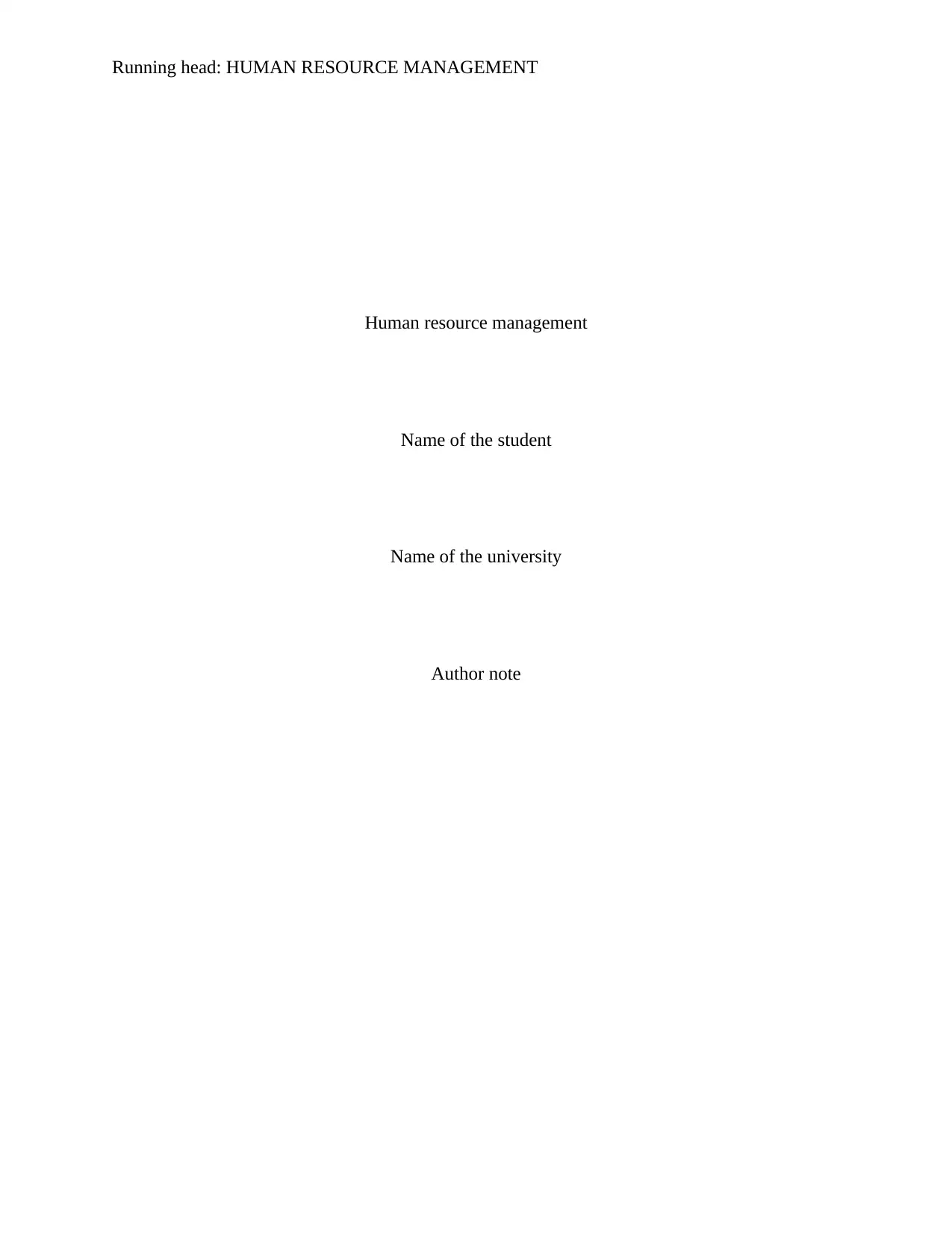
Running head: HUMAN RESOURCE MANAGEMENT
Human resource management
Name of the student
Name of the university
Author note
Human resource management
Name of the student
Name of the university
Author note
Paraphrase This Document
Need a fresh take? Get an instant paraphrase of this document with our AI Paraphraser

1HUMAN RESOURCE MANAGEMENT
Introduction
In the current business scenario, it is important for the contemporary business
organizations to have effective process of human resource management. This is due to the reason
that in the current generation of globalization, majority of the business organizations are
operating in multiple countries and thus they are having diverse sets of employees with different
approaches. It is difficult for the contemporary business organizations to manage these diverse
sets of employees from different perspectives. Moreover, it should also be noted that with time,
the expectations of the employees from their workplace are also getting changed and this is
important for the human resource managers to determine these changes and initiate strategies
accordingly (Jackson, Schuler & Jiang, 2014). In this case, the implemented human resource
management strategies should be flexible enough to cope up with the changes in the external
factors and maintain their effectiveness. However, on the other hand, it should also be noted that
factors to be considered in implementing the human resource management strategies are different
in different organizational situations.
In the given case study, it is identified that No Name is a leading aircraft manufacturer
from Australia with having their operations in China, Vietnam and Singapore as well. Thus, they
are operating in multiple countries and having employees from all these countries. However,
even though they are favorable business environment in terms of the external factors, but they
are facing issues internally. It is stated that they are facing issues in terms of training program for
the employees, managing the diversity, performance management of the employees and
maintenance of proper organizational culture. All these issues are actually causing the number of
problems and even takeover option is also considered. Thus, they are having the need of
Introduction
In the current business scenario, it is important for the contemporary business
organizations to have effective process of human resource management. This is due to the reason
that in the current generation of globalization, majority of the business organizations are
operating in multiple countries and thus they are having diverse sets of employees with different
approaches. It is difficult for the contemporary business organizations to manage these diverse
sets of employees from different perspectives. Moreover, it should also be noted that with time,
the expectations of the employees from their workplace are also getting changed and this is
important for the human resource managers to determine these changes and initiate strategies
accordingly (Jackson, Schuler & Jiang, 2014). In this case, the implemented human resource
management strategies should be flexible enough to cope up with the changes in the external
factors and maintain their effectiveness. However, on the other hand, it should also be noted that
factors to be considered in implementing the human resource management strategies are different
in different organizational situations.
In the given case study, it is identified that No Name is a leading aircraft manufacturer
from Australia with having their operations in China, Vietnam and Singapore as well. Thus, they
are operating in multiple countries and having employees from all these countries. However,
even though they are favorable business environment in terms of the external factors, but they
are facing issues internally. It is stated that they are facing issues in terms of training program for
the employees, managing the diversity, performance management of the employees and
maintenance of proper organizational culture. All these issues are actually causing the number of
problems and even takeover option is also considered. Thus, they are having the need of
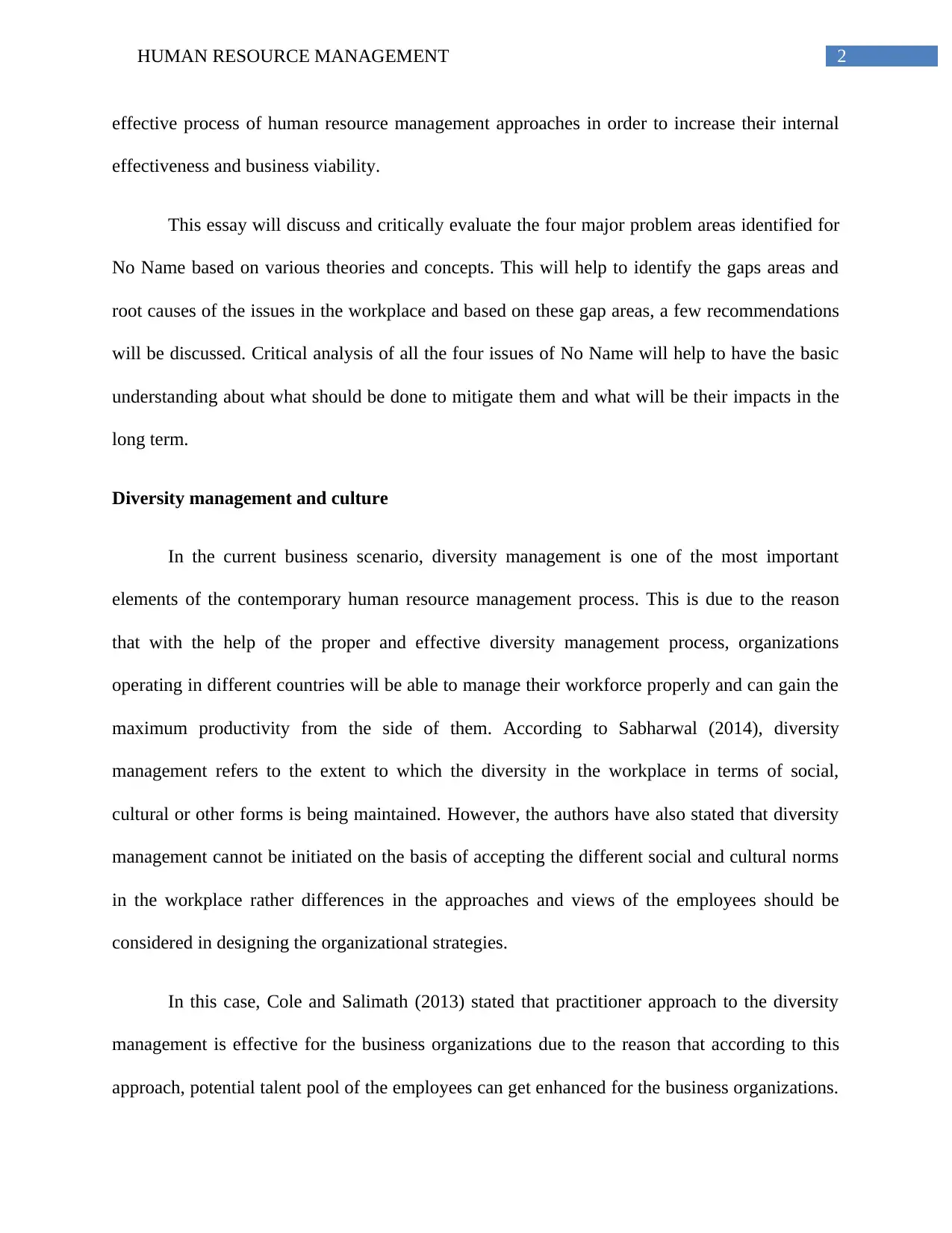
2HUMAN RESOURCE MANAGEMENT
effective process of human resource management approaches in order to increase their internal
effectiveness and business viability.
This essay will discuss and critically evaluate the four major problem areas identified for
No Name based on various theories and concepts. This will help to identify the gaps areas and
root causes of the issues in the workplace and based on these gap areas, a few recommendations
will be discussed. Critical analysis of all the four issues of No Name will help to have the basic
understanding about what should be done to mitigate them and what will be their impacts in the
long term.
Diversity management and culture
In the current business scenario, diversity management is one of the most important
elements of the contemporary human resource management process. This is due to the reason
that with the help of the proper and effective diversity management process, organizations
operating in different countries will be able to manage their workforce properly and can gain the
maximum productivity from the side of them. According to Sabharwal (2014), diversity
management refers to the extent to which the diversity in the workplace in terms of social,
cultural or other forms is being maintained. However, the authors have also stated that diversity
management cannot be initiated on the basis of accepting the different social and cultural norms
in the workplace rather differences in the approaches and views of the employees should be
considered in designing the organizational strategies.
In this case, Cole and Salimath (2013) stated that practitioner approach to the diversity
management is effective for the business organizations due to the reason that according to this
approach, potential talent pool of the employees can get enhanced for the business organizations.
effective process of human resource management approaches in order to increase their internal
effectiveness and business viability.
This essay will discuss and critically evaluate the four major problem areas identified for
No Name based on various theories and concepts. This will help to identify the gaps areas and
root causes of the issues in the workplace and based on these gap areas, a few recommendations
will be discussed. Critical analysis of all the four issues of No Name will help to have the basic
understanding about what should be done to mitigate them and what will be their impacts in the
long term.
Diversity management and culture
In the current business scenario, diversity management is one of the most important
elements of the contemporary human resource management process. This is due to the reason
that with the help of the proper and effective diversity management process, organizations
operating in different countries will be able to manage their workforce properly and can gain the
maximum productivity from the side of them. According to Sabharwal (2014), diversity
management refers to the extent to which the diversity in the workplace in terms of social,
cultural or other forms is being maintained. However, the authors have also stated that diversity
management cannot be initiated on the basis of accepting the different social and cultural norms
in the workplace rather differences in the approaches and views of the employees should be
considered in designing the organizational strategies.
In this case, Cole and Salimath (2013) stated that practitioner approach to the diversity
management is effective for the business organizations due to the reason that according to this
approach, potential talent pool of the employees can get enhanced for the business organizations.
⊘ This is a preview!⊘
Do you want full access?
Subscribe today to unlock all pages.

Trusted by 1+ million students worldwide
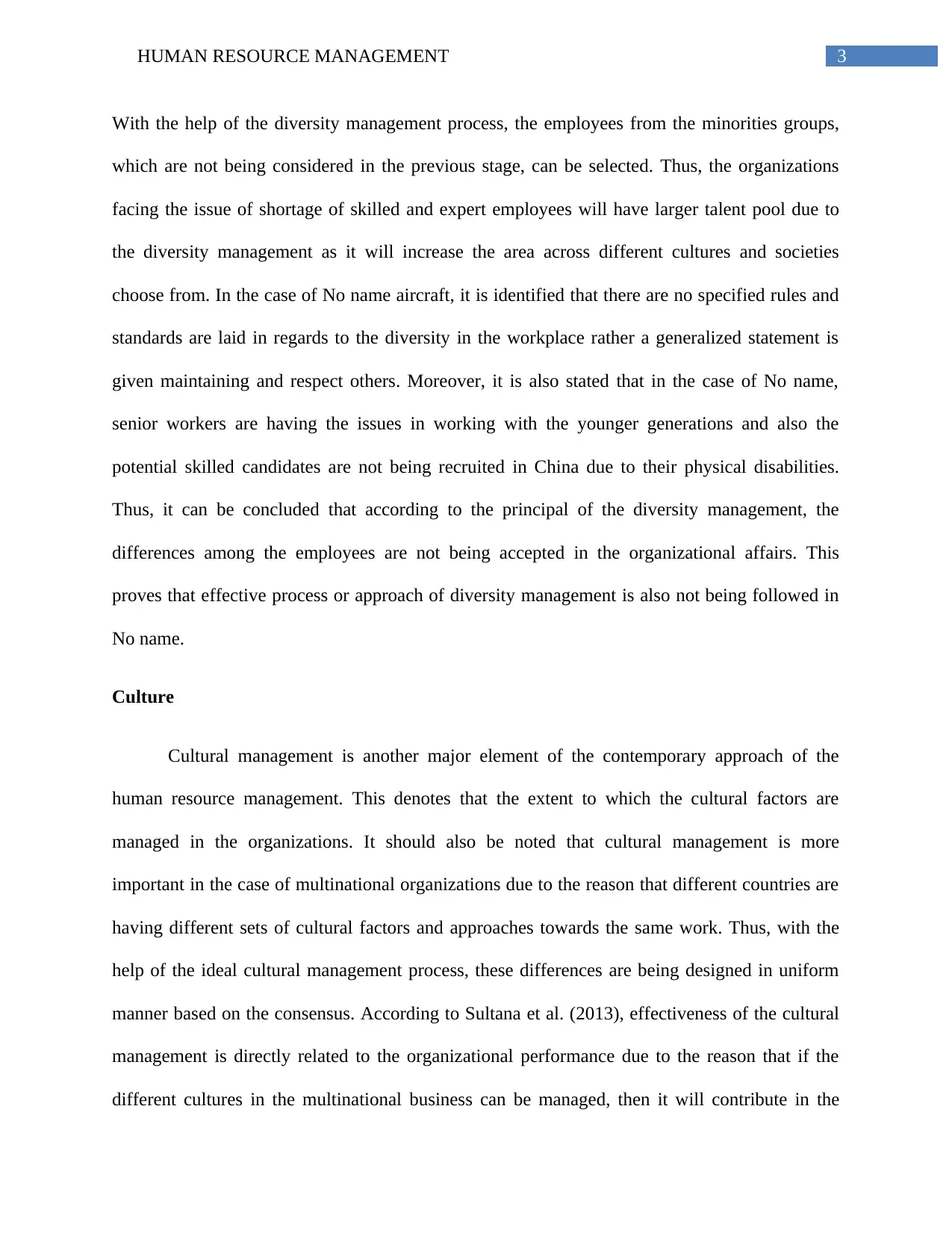
3HUMAN RESOURCE MANAGEMENT
With the help of the diversity management process, the employees from the minorities groups,
which are not being considered in the previous stage, can be selected. Thus, the organizations
facing the issue of shortage of skilled and expert employees will have larger talent pool due to
the diversity management as it will increase the area across different cultures and societies
choose from. In the case of No name aircraft, it is identified that there are no specified rules and
standards are laid in regards to the diversity in the workplace rather a generalized statement is
given maintaining and respect others. Moreover, it is also stated that in the case of No name,
senior workers are having the issues in working with the younger generations and also the
potential skilled candidates are not being recruited in China due to their physical disabilities.
Thus, it can be concluded that according to the principal of the diversity management, the
differences among the employees are not being accepted in the organizational affairs. This
proves that effective process or approach of diversity management is also not being followed in
No name.
Culture
Cultural management is another major element of the contemporary approach of the
human resource management. This denotes that the extent to which the cultural factors are
managed in the organizations. It should also be noted that cultural management is more
important in the case of multinational organizations due to the reason that different countries are
having different sets of cultural factors and approaches towards the same work. Thus, with the
help of the ideal cultural management process, these differences are being designed in uniform
manner based on the consensus. According to Sultana et al. (2013), effectiveness of the cultural
management is directly related to the organizational performance due to the reason that if the
different cultures in the multinational business can be managed, then it will contribute in the
With the help of the diversity management process, the employees from the minorities groups,
which are not being considered in the previous stage, can be selected. Thus, the organizations
facing the issue of shortage of skilled and expert employees will have larger talent pool due to
the diversity management as it will increase the area across different cultures and societies
choose from. In the case of No name aircraft, it is identified that there are no specified rules and
standards are laid in regards to the diversity in the workplace rather a generalized statement is
given maintaining and respect others. Moreover, it is also stated that in the case of No name,
senior workers are having the issues in working with the younger generations and also the
potential skilled candidates are not being recruited in China due to their physical disabilities.
Thus, it can be concluded that according to the principal of the diversity management, the
differences among the employees are not being accepted in the organizational affairs. This
proves that effective process or approach of diversity management is also not being followed in
No name.
Culture
Cultural management is another major element of the contemporary approach of the
human resource management. This denotes that the extent to which the cultural factors are
managed in the organizations. It should also be noted that cultural management is more
important in the case of multinational organizations due to the reason that different countries are
having different sets of cultural factors and approaches towards the same work. Thus, with the
help of the ideal cultural management process, these differences are being designed in uniform
manner based on the consensus. According to Sultana et al. (2013), effectiveness of the cultural
management is directly related to the organizational performance due to the reason that if the
different cultures in the multinational business can be managed, then it will contribute in the
Paraphrase This Document
Need a fresh take? Get an instant paraphrase of this document with our AI Paraphraser
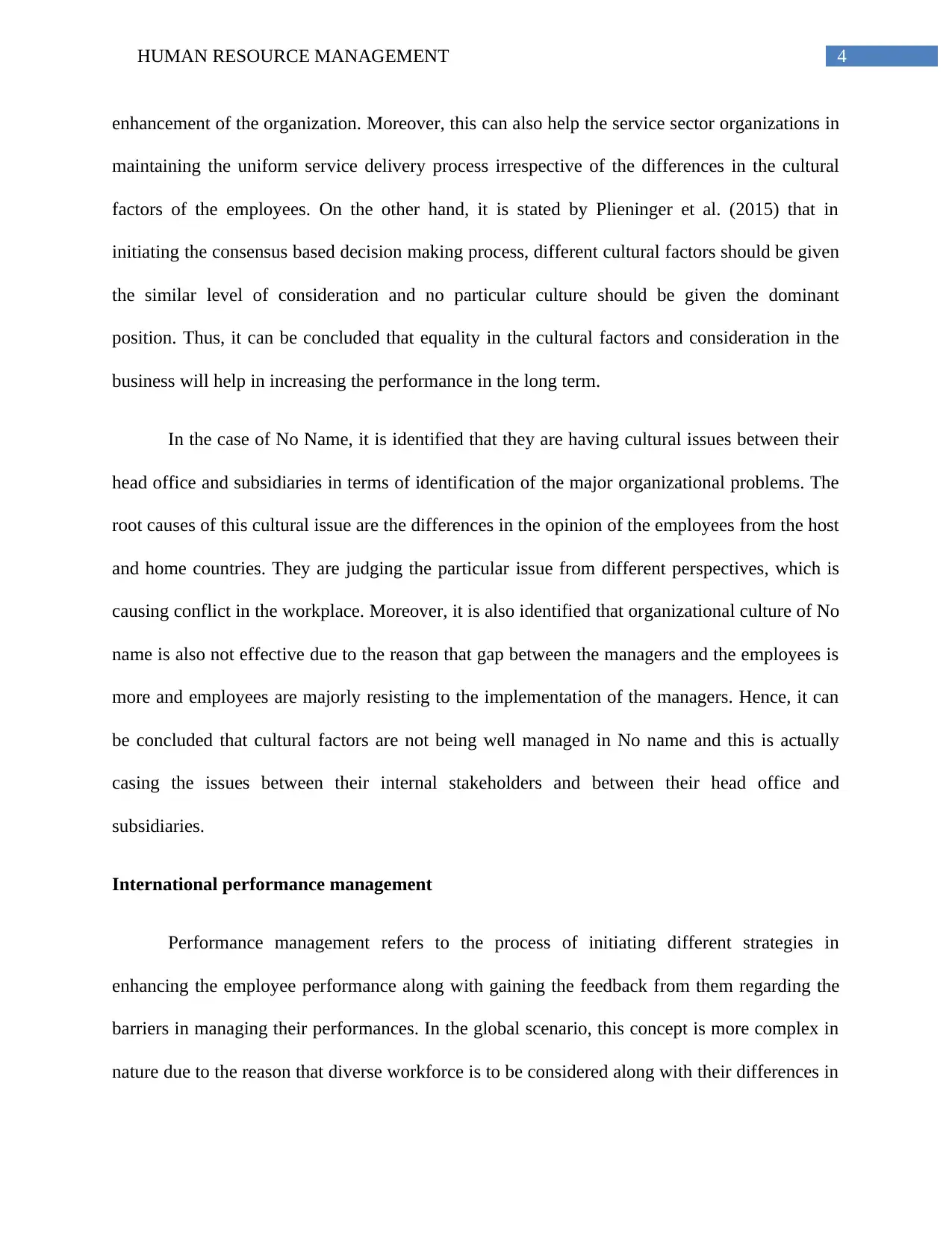
4HUMAN RESOURCE MANAGEMENT
enhancement of the organization. Moreover, this can also help the service sector organizations in
maintaining the uniform service delivery process irrespective of the differences in the cultural
factors of the employees. On the other hand, it is stated by Plieninger et al. (2015) that in
initiating the consensus based decision making process, different cultural factors should be given
the similar level of consideration and no particular culture should be given the dominant
position. Thus, it can be concluded that equality in the cultural factors and consideration in the
business will help in increasing the performance in the long term.
In the case of No Name, it is identified that they are having cultural issues between their
head office and subsidiaries in terms of identification of the major organizational problems. The
root causes of this cultural issue are the differences in the opinion of the employees from the host
and home countries. They are judging the particular issue from different perspectives, which is
causing conflict in the workplace. Moreover, it is also identified that organizational culture of No
name is also not effective due to the reason that gap between the managers and the employees is
more and employees are majorly resisting to the implementation of the managers. Hence, it can
be concluded that cultural factors are not being well managed in No name and this is actually
casing the issues between their internal stakeholders and between their head office and
subsidiaries.
International performance management
Performance management refers to the process of initiating different strategies in
enhancing the employee performance along with gaining the feedback from them regarding the
barriers in managing their performances. In the global scenario, this concept is more complex in
nature due to the reason that diverse workforce is to be considered along with their differences in
enhancement of the organization. Moreover, this can also help the service sector organizations in
maintaining the uniform service delivery process irrespective of the differences in the cultural
factors of the employees. On the other hand, it is stated by Plieninger et al. (2015) that in
initiating the consensus based decision making process, different cultural factors should be given
the similar level of consideration and no particular culture should be given the dominant
position. Thus, it can be concluded that equality in the cultural factors and consideration in the
business will help in increasing the performance in the long term.
In the case of No Name, it is identified that they are having cultural issues between their
head office and subsidiaries in terms of identification of the major organizational problems. The
root causes of this cultural issue are the differences in the opinion of the employees from the host
and home countries. They are judging the particular issue from different perspectives, which is
causing conflict in the workplace. Moreover, it is also identified that organizational culture of No
name is also not effective due to the reason that gap between the managers and the employees is
more and employees are majorly resisting to the implementation of the managers. Hence, it can
be concluded that cultural factors are not being well managed in No name and this is actually
casing the issues between their internal stakeholders and between their head office and
subsidiaries.
International performance management
Performance management refers to the process of initiating different strategies in
enhancing the employee performance along with gaining the feedback from them regarding the
barriers in managing their performances. In the global scenario, this concept is more complex in
nature due to the reason that diverse workforce is to be considered along with their differences in
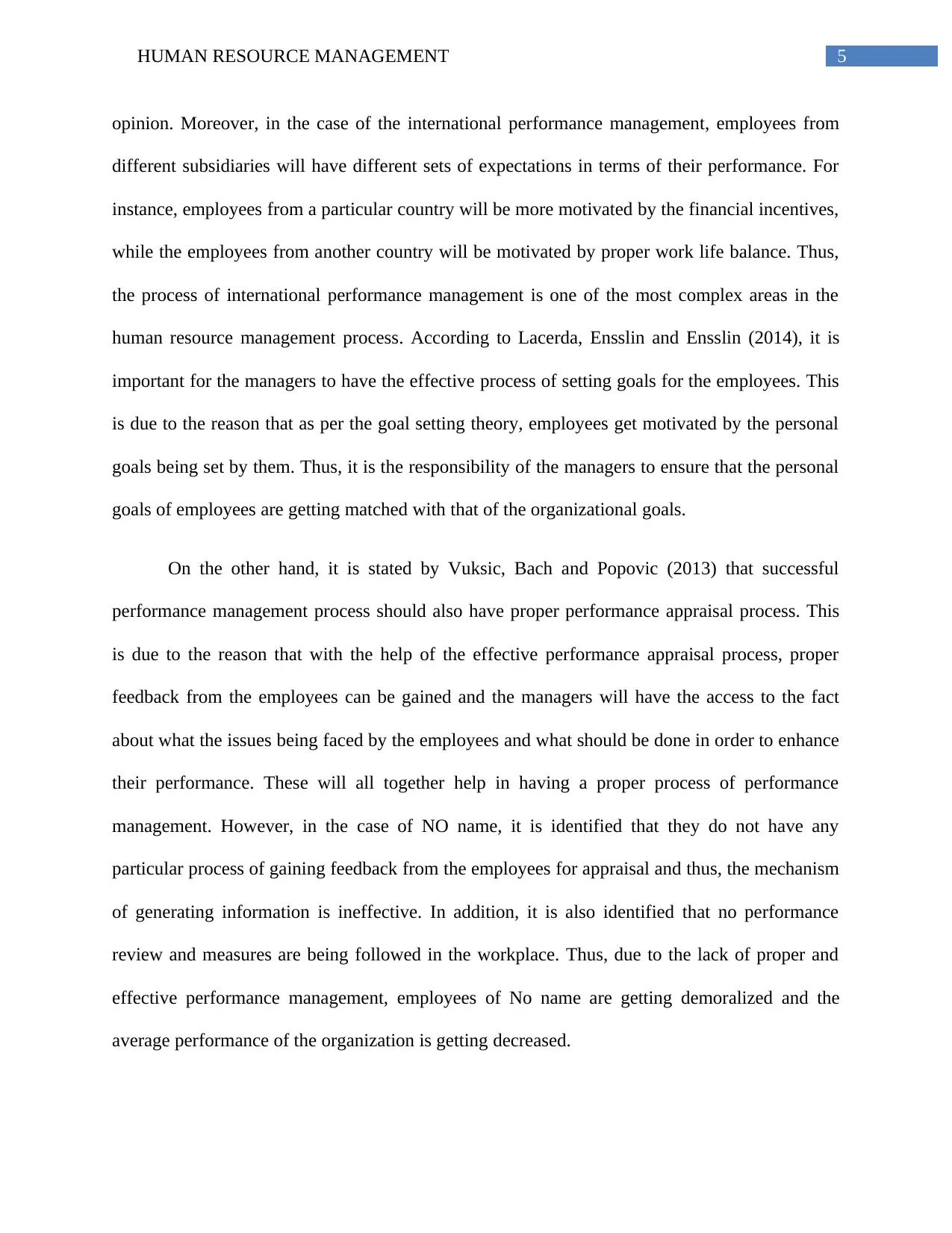
5HUMAN RESOURCE MANAGEMENT
opinion. Moreover, in the case of the international performance management, employees from
different subsidiaries will have different sets of expectations in terms of their performance. For
instance, employees from a particular country will be more motivated by the financial incentives,
while the employees from another country will be motivated by proper work life balance. Thus,
the process of international performance management is one of the most complex areas in the
human resource management process. According to Lacerda, Ensslin and Ensslin (2014), it is
important for the managers to have the effective process of setting goals for the employees. This
is due to the reason that as per the goal setting theory, employees get motivated by the personal
goals being set by them. Thus, it is the responsibility of the managers to ensure that the personal
goals of employees are getting matched with that of the organizational goals.
On the other hand, it is stated by Vuksic, Bach and Popovic (2013) that successful
performance management process should also have proper performance appraisal process. This
is due to the reason that with the help of the effective performance appraisal process, proper
feedback from the employees can be gained and the managers will have the access to the fact
about what the issues being faced by the employees and what should be done in order to enhance
their performance. These will all together help in having a proper process of performance
management. However, in the case of NO name, it is identified that they do not have any
particular process of gaining feedback from the employees for appraisal and thus, the mechanism
of generating information is ineffective. In addition, it is also identified that no performance
review and measures are being followed in the workplace. Thus, due to the lack of proper and
effective performance management, employees of No name are getting demoralized and the
average performance of the organization is getting decreased.
opinion. Moreover, in the case of the international performance management, employees from
different subsidiaries will have different sets of expectations in terms of their performance. For
instance, employees from a particular country will be more motivated by the financial incentives,
while the employees from another country will be motivated by proper work life balance. Thus,
the process of international performance management is one of the most complex areas in the
human resource management process. According to Lacerda, Ensslin and Ensslin (2014), it is
important for the managers to have the effective process of setting goals for the employees. This
is due to the reason that as per the goal setting theory, employees get motivated by the personal
goals being set by them. Thus, it is the responsibility of the managers to ensure that the personal
goals of employees are getting matched with that of the organizational goals.
On the other hand, it is stated by Vuksic, Bach and Popovic (2013) that successful
performance management process should also have proper performance appraisal process. This
is due to the reason that with the help of the effective performance appraisal process, proper
feedback from the employees can be gained and the managers will have the access to the fact
about what the issues being faced by the employees and what should be done in order to enhance
their performance. These will all together help in having a proper process of performance
management. However, in the case of NO name, it is identified that they do not have any
particular process of gaining feedback from the employees for appraisal and thus, the mechanism
of generating information is ineffective. In addition, it is also identified that no performance
review and measures are being followed in the workplace. Thus, due to the lack of proper and
effective performance management, employees of No name are getting demoralized and the
average performance of the organization is getting decreased.
⊘ This is a preview!⊘
Do you want full access?
Subscribe today to unlock all pages.

Trusted by 1+ million students worldwide
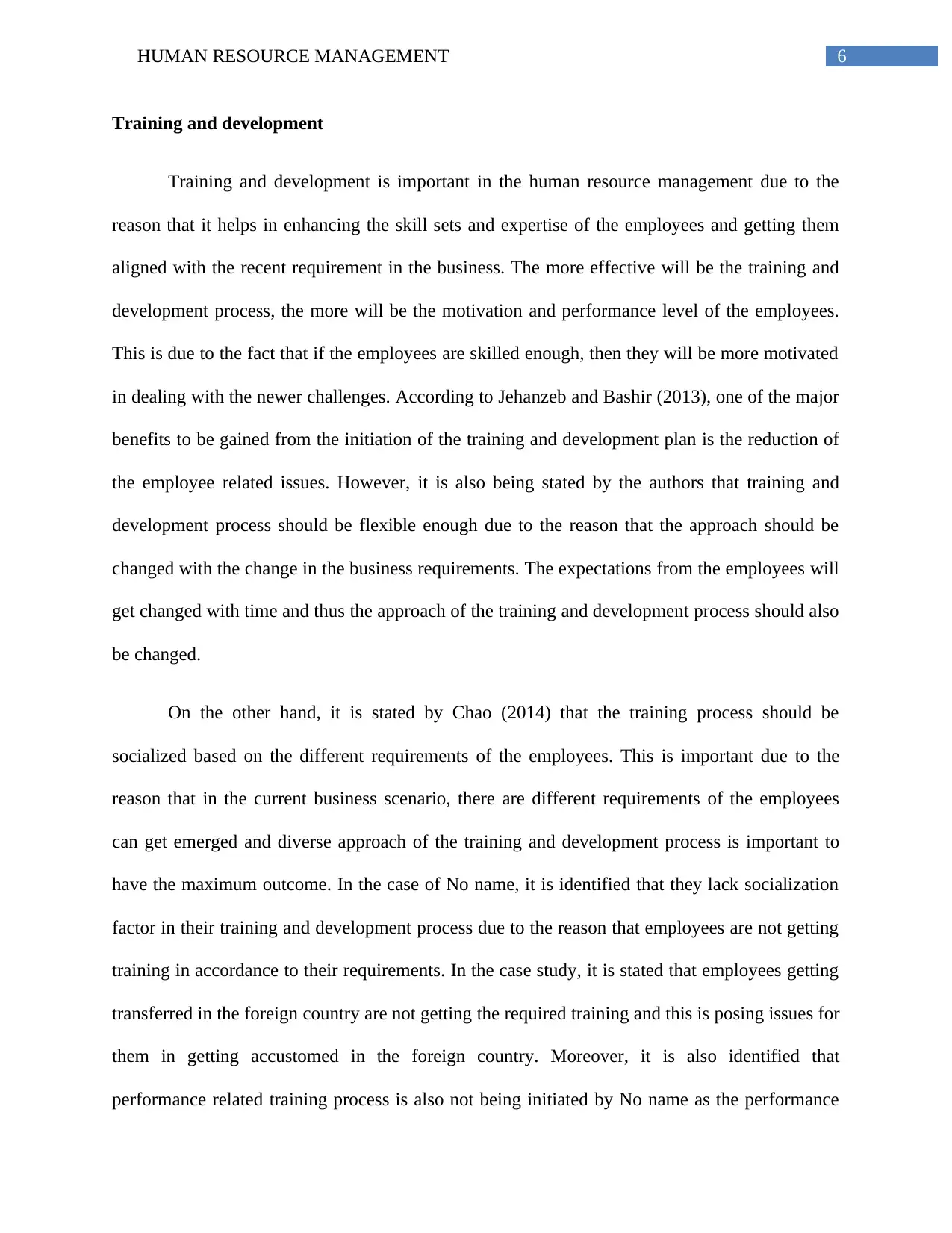
6HUMAN RESOURCE MANAGEMENT
Training and development
Training and development is important in the human resource management due to the
reason that it helps in enhancing the skill sets and expertise of the employees and getting them
aligned with the recent requirement in the business. The more effective will be the training and
development process, the more will be the motivation and performance level of the employees.
This is due to the fact that if the employees are skilled enough, then they will be more motivated
in dealing with the newer challenges. According to Jehanzeb and Bashir (2013), one of the major
benefits to be gained from the initiation of the training and development plan is the reduction of
the employee related issues. However, it is also being stated by the authors that training and
development process should be flexible enough due to the reason that the approach should be
changed with the change in the business requirements. The expectations from the employees will
get changed with time and thus the approach of the training and development process should also
be changed.
On the other hand, it is stated by Chao (2014) that the training process should be
socialized based on the different requirements of the employees. This is important due to the
reason that in the current business scenario, there are different requirements of the employees
can get emerged and diverse approach of the training and development process is important to
have the maximum outcome. In the case of No name, it is identified that they lack socialization
factor in their training and development process due to the reason that employees are not getting
training in accordance to their requirements. In the case study, it is stated that employees getting
transferred in the foreign country are not getting the required training and this is posing issues for
them in getting accustomed in the foreign country. Moreover, it is also identified that
performance related training process is also not being initiated by No name as the performance
Training and development
Training and development is important in the human resource management due to the
reason that it helps in enhancing the skill sets and expertise of the employees and getting them
aligned with the recent requirement in the business. The more effective will be the training and
development process, the more will be the motivation and performance level of the employees.
This is due to the fact that if the employees are skilled enough, then they will be more motivated
in dealing with the newer challenges. According to Jehanzeb and Bashir (2013), one of the major
benefits to be gained from the initiation of the training and development plan is the reduction of
the employee related issues. However, it is also being stated by the authors that training and
development process should be flexible enough due to the reason that the approach should be
changed with the change in the business requirements. The expectations from the employees will
get changed with time and thus the approach of the training and development process should also
be changed.
On the other hand, it is stated by Chao (2014) that the training process should be
socialized based on the different requirements of the employees. This is important due to the
reason that in the current business scenario, there are different requirements of the employees
can get emerged and diverse approach of the training and development process is important to
have the maximum outcome. In the case of No name, it is identified that they lack socialization
factor in their training and development process due to the reason that employees are not getting
training in accordance to their requirements. In the case study, it is stated that employees getting
transferred in the foreign country are not getting the required training and this is posing issues for
them in getting accustomed in the foreign country. Moreover, it is also identified that
performance related training process is also not being initiated by No name as the performance
Paraphrase This Document
Need a fresh take? Get an instant paraphrase of this document with our AI Paraphraser

7HUMAN RESOURCE MANAGEMENT
of the employees is getting decreased without having any training process. Thus, it can be
concluded that No name is not having the effective process of training and development and this
is affecting their employee management process including their level of motivation and
performance.
Conclusion
Thus it can be concluded that there are number of issues being faced by No name in
terms of their business process. However, it should be noted that majority of these issues are due
to their ineffective approach of human resource management. It is identified that training and
development, culture, international performance management and managing diversity are the
four areas, which are causing issues for No name. Thus, these are the major gap areas in their
business process. In this essay, the root causes of these issues are being identified on the basis of
different opinions being given by the authors and on the basis of different theories. Comparison
with these theories helped to identify that ideal process of human resource approaches is not
being followed by them. There are number of impacts to be faced by No name in terms of their
in effective human resource management are also being identified. Some of these impacts will be
the reduction in the employee effectiveness, organizational performance and increase in the
attrition rate. Hence, this essay concludes that No name is having the need for effective process
of human resource management process to prevent the brand from taking over by others. A few
recommended steps will be discussed in the new section, which can help them to mitigate the
identified risks and enhance the effectiveness of the human resources processes.
Recommendations
It is recommended that No name should initiate the process of 360 degree feedback
of the employees is getting decreased without having any training process. Thus, it can be
concluded that No name is not having the effective process of training and development and this
is affecting their employee management process including their level of motivation and
performance.
Conclusion
Thus it can be concluded that there are number of issues being faced by No name in
terms of their business process. However, it should be noted that majority of these issues are due
to their ineffective approach of human resource management. It is identified that training and
development, culture, international performance management and managing diversity are the
four areas, which are causing issues for No name. Thus, these are the major gap areas in their
business process. In this essay, the root causes of these issues are being identified on the basis of
different opinions being given by the authors and on the basis of different theories. Comparison
with these theories helped to identify that ideal process of human resource approaches is not
being followed by them. There are number of impacts to be faced by No name in terms of their
in effective human resource management are also being identified. Some of these impacts will be
the reduction in the employee effectiveness, organizational performance and increase in the
attrition rate. Hence, this essay concludes that No name is having the need for effective process
of human resource management process to prevent the brand from taking over by others. A few
recommended steps will be discussed in the new section, which can help them to mitigate the
identified risks and enhance the effectiveness of the human resources processes.
Recommendations
It is recommended that No name should initiate the process of 360 degree feedback
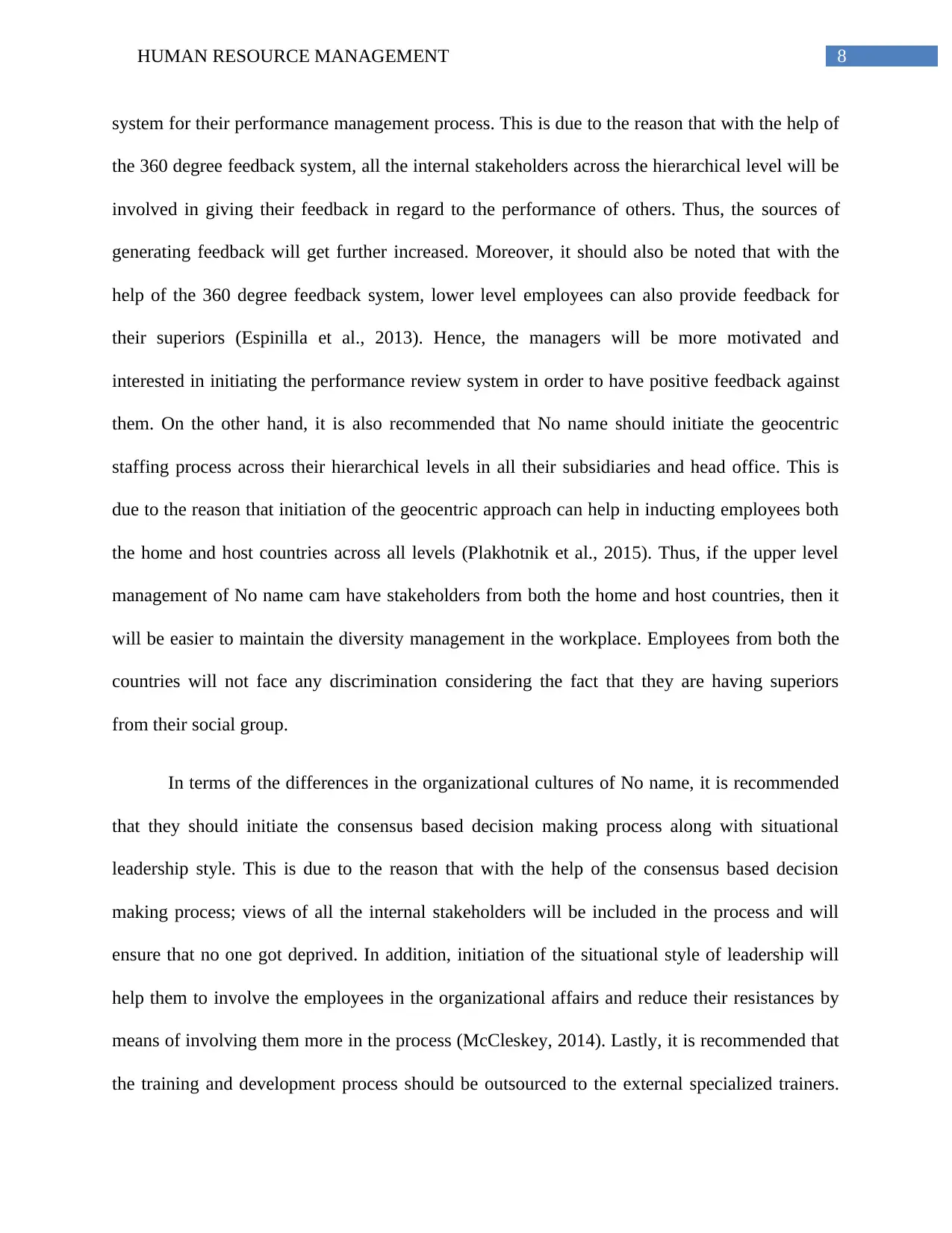
8HUMAN RESOURCE MANAGEMENT
system for their performance management process. This is due to the reason that with the help of
the 360 degree feedback system, all the internal stakeholders across the hierarchical level will be
involved in giving their feedback in regard to the performance of others. Thus, the sources of
generating feedback will get further increased. Moreover, it should also be noted that with the
help of the 360 degree feedback system, lower level employees can also provide feedback for
their superiors (Espinilla et al., 2013). Hence, the managers will be more motivated and
interested in initiating the performance review system in order to have positive feedback against
them. On the other hand, it is also recommended that No name should initiate the geocentric
staffing process across their hierarchical levels in all their subsidiaries and head office. This is
due to the reason that initiation of the geocentric approach can help in inducting employees both
the home and host countries across all levels (Plakhotnik et al., 2015). Thus, if the upper level
management of No name cam have stakeholders from both the home and host countries, then it
will be easier to maintain the diversity management in the workplace. Employees from both the
countries will not face any discrimination considering the fact that they are having superiors
from their social group.
In terms of the differences in the organizational cultures of No name, it is recommended
that they should initiate the consensus based decision making process along with situational
leadership style. This is due to the reason that with the help of the consensus based decision
making process; views of all the internal stakeholders will be included in the process and will
ensure that no one got deprived. In addition, initiation of the situational style of leadership will
help them to involve the employees in the organizational affairs and reduce their resistances by
means of involving them more in the process (McCleskey, 2014). Lastly, it is recommended that
the training and development process should be outsourced to the external specialized trainers.
system for their performance management process. This is due to the reason that with the help of
the 360 degree feedback system, all the internal stakeholders across the hierarchical level will be
involved in giving their feedback in regard to the performance of others. Thus, the sources of
generating feedback will get further increased. Moreover, it should also be noted that with the
help of the 360 degree feedback system, lower level employees can also provide feedback for
their superiors (Espinilla et al., 2013). Hence, the managers will be more motivated and
interested in initiating the performance review system in order to have positive feedback against
them. On the other hand, it is also recommended that No name should initiate the geocentric
staffing process across their hierarchical levels in all their subsidiaries and head office. This is
due to the reason that initiation of the geocentric approach can help in inducting employees both
the home and host countries across all levels (Plakhotnik et al., 2015). Thus, if the upper level
management of No name cam have stakeholders from both the home and host countries, then it
will be easier to maintain the diversity management in the workplace. Employees from both the
countries will not face any discrimination considering the fact that they are having superiors
from their social group.
In terms of the differences in the organizational cultures of No name, it is recommended
that they should initiate the consensus based decision making process along with situational
leadership style. This is due to the reason that with the help of the consensus based decision
making process; views of all the internal stakeholders will be included in the process and will
ensure that no one got deprived. In addition, initiation of the situational style of leadership will
help them to involve the employees in the organizational affairs and reduce their resistances by
means of involving them more in the process (McCleskey, 2014). Lastly, it is recommended that
the training and development process should be outsourced to the external specialized trainers.
⊘ This is a preview!⊘
Do you want full access?
Subscribe today to unlock all pages.

Trusted by 1+ million students worldwide

9HUMAN RESOURCE MANAGEMENT
This will ensure that the highest quality of training process is being followed in the organization.
In addition, the external trainers will have the more knowledge about how to enhance the skill
sets of the employees at any given point of time (van der Locht, van Dam & Chiaburu, 2013).
Hence, the entire training and development process will get enhanced.
This will ensure that the highest quality of training process is being followed in the organization.
In addition, the external trainers will have the more knowledge about how to enhance the skill
sets of the employees at any given point of time (van der Locht, van Dam & Chiaburu, 2013).
Hence, the entire training and development process will get enhanced.
Paraphrase This Document
Need a fresh take? Get an instant paraphrase of this document with our AI Paraphraser
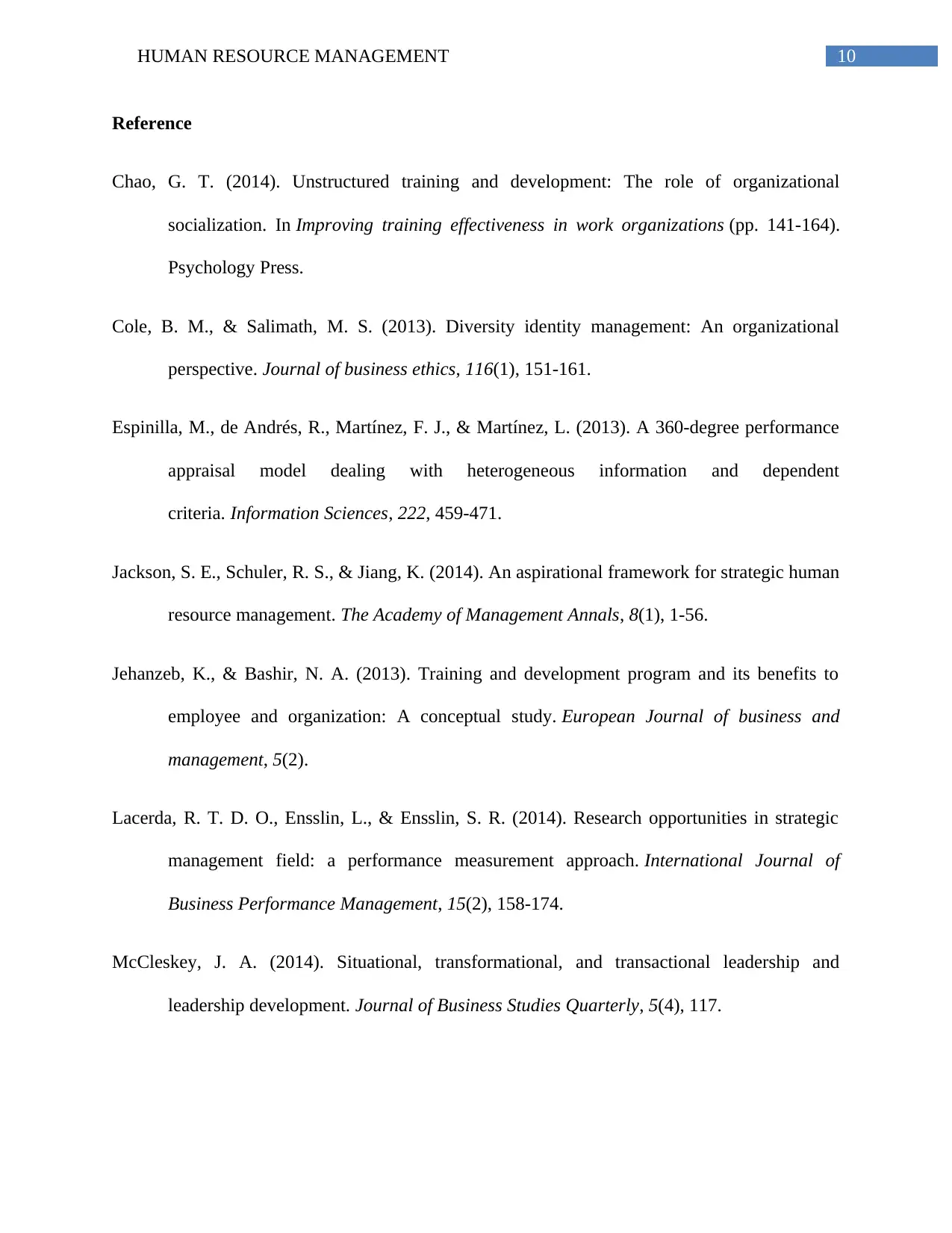
10HUMAN RESOURCE MANAGEMENT
Reference
Chao, G. T. (2014). Unstructured training and development: The role of organizational
socialization. In Improving training effectiveness in work organizations (pp. 141-164).
Psychology Press.
Cole, B. M., & Salimath, M. S. (2013). Diversity identity management: An organizational
perspective. Journal of business ethics, 116(1), 151-161.
Espinilla, M., de Andrés, R., Martínez, F. J., & Martínez, L. (2013). A 360-degree performance
appraisal model dealing with heterogeneous information and dependent
criteria. Information Sciences, 222, 459-471.
Jackson, S. E., Schuler, R. S., & Jiang, K. (2014). An aspirational framework for strategic human
resource management. The Academy of Management Annals, 8(1), 1-56.
Jehanzeb, K., & Bashir, N. A. (2013). Training and development program and its benefits to
employee and organization: A conceptual study. European Journal of business and
management, 5(2).
Lacerda, R. T. D. O., Ensslin, L., & Ensslin, S. R. (2014). Research opportunities in strategic
management field: a performance measurement approach. International Journal of
Business Performance Management, 15(2), 158-174.
McCleskey, J. A. (2014). Situational, transformational, and transactional leadership and
leadership development. Journal of Business Studies Quarterly, 5(4), 117.
Reference
Chao, G. T. (2014). Unstructured training and development: The role of organizational
socialization. In Improving training effectiveness in work organizations (pp. 141-164).
Psychology Press.
Cole, B. M., & Salimath, M. S. (2013). Diversity identity management: An organizational
perspective. Journal of business ethics, 116(1), 151-161.
Espinilla, M., de Andrés, R., Martínez, F. J., & Martínez, L. (2013). A 360-degree performance
appraisal model dealing with heterogeneous information and dependent
criteria. Information Sciences, 222, 459-471.
Jackson, S. E., Schuler, R. S., & Jiang, K. (2014). An aspirational framework for strategic human
resource management. The Academy of Management Annals, 8(1), 1-56.
Jehanzeb, K., & Bashir, N. A. (2013). Training and development program and its benefits to
employee and organization: A conceptual study. European Journal of business and
management, 5(2).
Lacerda, R. T. D. O., Ensslin, L., & Ensslin, S. R. (2014). Research opportunities in strategic
management field: a performance measurement approach. International Journal of
Business Performance Management, 15(2), 158-174.
McCleskey, J. A. (2014). Situational, transformational, and transactional leadership and
leadership development. Journal of Business Studies Quarterly, 5(4), 117.

11HUMAN RESOURCE MANAGEMENT
Mor, S., Morris, M. W., & Joh, J. (2013). Identifying and training adaptive cross-cultural
management skills: The crucial role of cultural metacognition. Academy of Management
Learning & Education, 12(3), 453-475.
Plakhotnik, M. S., Rocco, T. S., Collins, J. C., & Landorf, H. (2015). Connection, value, and
growth: How employees with different national identities experience a geocentric
organizational culture of a global corporation. Human Resource Development
International, 18(1), 39-57.
Plieninger, T., Bieling, C., Fagerholm, N., Byg, A., Hartel, T., Hurley, P., ... & Van Der Horst,
D. (2015). The role of cultural ecosystem services in landscape management and
planning. Current Opinion in Environmental Sustainability, 14, 28-33.
Sabharwal, M. (2014). Is diversity management sufficient? Organizational inclusion to further
performance. Public Personnel Management, 43(2), 197-217.
Sultana, M., Rashid, M., Mohiuddin, M., & Mazumder, M. (2013). Cross-cultural management
and organizational performance: A content analysis perspective. Cross-Cultural
Management and Organizational Performance: A Content Analysis Perspective, 133-
146.
van der Locht, M., van Dam, K., & Chiaburu, D. S. (2013). Getting the most of management
training: the role of identical elements for training transfer. Personnel Review, 42(4),
422-439.
Mor, S., Morris, M. W., & Joh, J. (2013). Identifying and training adaptive cross-cultural
management skills: The crucial role of cultural metacognition. Academy of Management
Learning & Education, 12(3), 453-475.
Plakhotnik, M. S., Rocco, T. S., Collins, J. C., & Landorf, H. (2015). Connection, value, and
growth: How employees with different national identities experience a geocentric
organizational culture of a global corporation. Human Resource Development
International, 18(1), 39-57.
Plieninger, T., Bieling, C., Fagerholm, N., Byg, A., Hartel, T., Hurley, P., ... & Van Der Horst,
D. (2015). The role of cultural ecosystem services in landscape management and
planning. Current Opinion in Environmental Sustainability, 14, 28-33.
Sabharwal, M. (2014). Is diversity management sufficient? Organizational inclusion to further
performance. Public Personnel Management, 43(2), 197-217.
Sultana, M., Rashid, M., Mohiuddin, M., & Mazumder, M. (2013). Cross-cultural management
and organizational performance: A content analysis perspective. Cross-Cultural
Management and Organizational Performance: A Content Analysis Perspective, 133-
146.
van der Locht, M., van Dam, K., & Chiaburu, D. S. (2013). Getting the most of management
training: the role of identical elements for training transfer. Personnel Review, 42(4),
422-439.
⊘ This is a preview!⊘
Do you want full access?
Subscribe today to unlock all pages.

Trusted by 1+ million students worldwide
1 out of 13
Related Documents
Your All-in-One AI-Powered Toolkit for Academic Success.
+13062052269
info@desklib.com
Available 24*7 on WhatsApp / Email
![[object Object]](/_next/static/media/star-bottom.7253800d.svg)
Unlock your academic potential
Copyright © 2020–2025 A2Z Services. All Rights Reserved. Developed and managed by ZUCOL.




